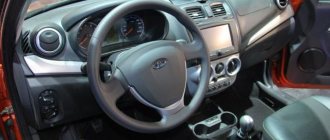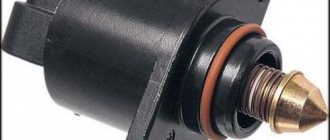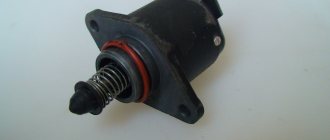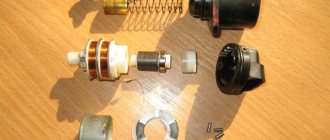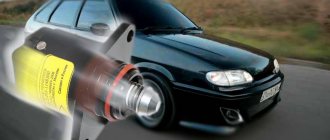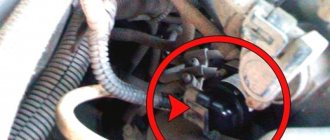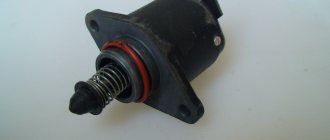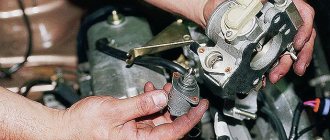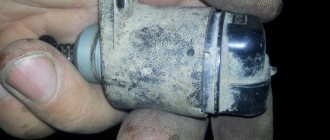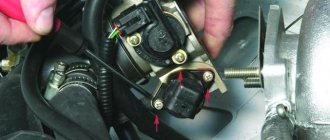How to repair idle speed on a VAZ 2109 carburetor engine
On cars of the VAZ 2109 family, Solex-type carburetors are used, which have an electromagnetic valve (EMV) with an idle jet in the idle speed system.
The valve is controlled by the electronic forced idle unit. There are three most common causes of idle speed disappearance:
- clogging of the EMC idle jet;
- EMC burnout;
- lack of power supply to the EMC.
For work you need: wrenches “8”, “10”, “12”, “13”, “14”, a 12 V probe or test lamp with wires, a piece of wire with stripped ends, a compressor or air pump.
Remove the air filter housing cover by unscrewing the nut with a “10” wrench and unfastening the spring clips. Remove the air filter.
We unscrew the four nuts with a key “8”, use a screwdriver to loosen the clamp of the crankcase ventilation hose at the point of connection to the valve cover and remove the air filter housing.
Turn on the ignition. Remove the power wire from the solenoid valve.
We try to touch the power wire terminal to the EMC terminal several times. At the moment of contact, distinct clicks should be heard. If this is not the case, then unscrew the EMC from the carburetor cover. Using an additional piece of wire, we apply the “+” from the battery to the terminal of the EMC, and with its body we touch the “–” terminal of the battery several times. At the moment of contact, distinct clicks should be heard.
If there are no clicks, the valve is burnt out. We replace it with a serviceable one, after checking it first.
To get to the nearest auto shop, you can convert a faulty EMC into a forced open one. To do this, remove the idle fuel jet with two fingers, break off the plastic tip of the valve, and put the jet and EMC in place.
We put the wires in place and start the engine. When using such a valve, problems may arise with turning off the engine: it will try to work after the ignition is turned off. In such a situation, you don’t need to turn it off right away, but let it run for 1-2 minutes, and after turning off the ignition, smoothly press the gas pedal all the way.
If the EMC is working normally, you need to check the idle jet. To do this, unscrew the valve from the carburetor cover. Using two fingers, remove the idle fuel jet. Pay attention to the central hole: remove debris from it using a compressor or air pump.
We install the jet and EMC in place and tighten it until it stops.
If the solenoid valve is working properly, the jet is not clogged, and there is still no idle speed, then the electronic forced idle speed control unit may have failed.
How to check it? Turn on the ignition and check with a tester or test lamp for the presence of “+” at the terminal of the EMC power wire.
If there is no power, the electronic forced idle control unit has failed. It cannot be repaired. Replacing it is not difficult. To get to the nearest auto shop, you can temporarily use an additional wire to supply power to the EMC at least from the “+B” terminal of the ignition coil. As an option, you can first bend the rubber cover from the connector of the wire bundle of the forced idle block and connect the wires at terminals “4” and “6” with a jumper. The numbering order of the terminals is indicated on the cover of the electronic unit to the right and left of the connector - numbers “1” and “7”.
A frequent malfunction of the engine associated with the forced idle block is a significant decrease in rotation speed (up to a complete stop) when the clutch is depressed, for example, when changing gears or stopping at a traffic light. In this case, in order to safely get to a car shop or service center, it is enough to disconnect the connector of the control circuit of the forced idle unit, located near the mixture amount adjusting screw.
Checking and repairing the EPH system of carburetor 2108, 21081, 21083 Solex
The forced idle economizer system of the carburetor 2108, 21081, 21083 Solex and its modifications is designed to forcibly shut off the fuel supply to the engine cylinders through the carburetor idle system during engine braking (coasting with the gear engaged and the gas pedal fully released).
It also prevents fuel from entering the engine after it is stopped, thereby preventing it from operating with the ignition off (glow ignition).
Signs of malfunction of the EPH system of carburetors 2108, 21081, 21083 Solex
— No or unstable idle. The engine stalls or runs rough
— The engine stalls in engine braking mode (when coasting with the gear engaged and the gas pedal fully released).
— The engine stalls when the gas is suddenly released at speeds above average (2000 and above) .
— After stopping and turning off the ignition, several flashes occur in the cylinders (dieseling).
Causes of malfunction of the EPH system
— The solenoid valve is faulty. — The solenoid valve control unit is faulty. — The contact of the fuel mixture “amount” screw is oxidized, dirty or damaged. — The connecting wires are damaged or their tips are oxidized. — The connectors of the connecting blocks have come off.
Tools for repair
— Open-end wrench 13 mm. — A piece of wire 0.5 meters. — Tachometer. — Voltmeter. — Ohmmeter.
Or one multimeter or autotester that can work in all these modes.
Checking and repairing the Solex carburetor solenoid valve
1. Remove the wire end from the solenoid valve.
2. Turn on the ignition.
3. Put the wire end back on.
4. You should hear a click when the valve operates.
If there is no click, then use a piece of wire to connect the positive terminal of the battery and the terminal of the solenoid valve. There is a click - the valve is working, but the control unit or connecting wires are faulty. There is no click - the valve itself is faulty and must be replaced.
This is the solenoid valve of the 21083 Solex carburetor. There is a marking on the jet 41.
EMK 21083
And this is the solenoid valve of the carburetor 2108, 21081 Solex. It has a slightly different shape and is already marked on the fuel nozzle 42.
EMK 2108
Both valves are interchangeable.
In addition, you can check the serviceability of the solenoid valve and the correct installation by removing the wire tip from the valve outlet with the engine idling. The engine should stall. If it does not stall, then the needle may be stuck in the valve or it may not be fully tightened.
We unscrew the valve, remove the fuel nozzle from it, and check the mobility of its needle. We wrap the valve back by hand, do not put the wire on it yet, start the engine and then continue to wrap it with an open-end wrench. Turn it in slowly until the engine starts to stall. Next, we put a wire on the output of the solenoid valve - the engine should start normally, and stall after disconnecting the wire. For more details, see “Features of installing the Solex solenoid valve.”
It may be necessary to slightly rotate the valve with a key back and forth (with the wire end on) in order to achieve more stable engine operation.
There is no need to repair the valve if it malfunctions. We replace the faulty valve with a new one.
Checking and repairing the control unit of the EPH system of the Solex carburetor
1. Take a voltmeter and connect one of its terminals to the terminal of the solenoid valve, and the other terminal to the “ground” of the car (the “ground” can be a body part, a metal part of the engine, or the “minus” of the battery).
2. Connect the tachometer.
3. Start the engine and look at the voltmeter.
4. At idle, the voltage must be at least 10 V (equal to the on-board voltage).
5. We increase the engine speed to 4000 rpm and sharply reset.
You can press the gas pedal or rotate the throttle control lever with your hand.
6. When the speed is reduced to 1900 rpm, the voltage should drop to 0.5 V, and when it decreases below 1900 rpm, it should rise again to at least 10 V. If this does not happen, the EPHH control unit is faulty
Checking the operation of the EPH system of the Solex carburetor using a voltmeter (multimeter) - instrument readings when idling with the gas pedal not pressed and the throttle valves closed
Repair of the control unit consists of replacing it with a new one.
Do not lose sight of the fact that there are several types of control units used on different cars with a Solex carburetor. Their response thresholds are different.
For example, some block modifications:
5003.3761 - used on VAZ 2108, 2109, 21099 cars, “Tavria” turns off the valve at speeds above 2100, turns it on at 1900 rpm.
502.3761 - used on Moskvich 2141 cars with a Solex carburetor, turns off the valve at 1500, turns it on at 1250.
5013.3761 - VAZ 2104, 2105, 2107, 2121 cars with a Solex carburetor, turns off above 1900, turns on below 1700 rpm.
Checking and repairing the “quantity” screw of the fuel mixture of the Solex carburetor
If you suspect a malfunction of the “quantity” screw (the contact is oxidized or damaged, the screw wire is broken), it is necessary to check it. — We connect a voltmeter to the carburetor EMC, the same way as when checking the block. — Let's start the engine. — Set the speed within 2200-2300 rpm.
Idle speed sensor VAZ 21099 carburetor
Home » Fuel system » Sensors » Idle speed sensor VAZ 2109 carburetor
VAZ cars 2108, 2109, 21099 are equipped with Solex carburetors. This type of carburetor is equipped with a solenoid valve that has an idle jet. In everyday use of a car, the most likely cause of idle loss is the idle speed sensor of the VAZ 2109 carburetor.
The Petrolich saver is a new invention that is designed to save car fuel consumption, according to the manufacturer, by 10-25%, by simply inserting it into the car’s cigarette lighter. The saver is intended only for cars with an on-board voltage of 12V. In some cars, the light diodes light up even after the engine is turned off.
The following malfunctions may occur here: 1). Basically, the solenoid valve jet becomes clogged; 2). Winding failure; 3). There is no power to the solenoid valve (EMV).
To correct the operation of the idle speed sensor, you need to have wrenches 8, 10, 12, 13, 14, wires, a compressor, a twelve-volt light bulb.
Algorithm for checking the idle speed sensor with your own hands: 1. It is necessary to remove the air filter cover, using a ten key, unscrew the air filter cover nut. 2. Next you need to remove the air filter itself. 3. Unscrew the 4. Nuts securing the lower part of the air filter with an eight-point wrench. 4. Remove the lower part of the air filter from the studs. 5. Start the car, remove the terminal on the solenoid valve and touch the solenoid valve contact repeatedly until you hear a clicking sound. 6. If there are clicks, you need to turn off the engine and use a thirteen key to unscrew the solenoid valve. Particular attention should be paid to the fuel nozzle: it is necessary to thoroughly blow out the fuel nozzle using a pump or compressor and put it in place. Reassemble all parts in reverse order. 7. If there are no clicks, then turn the solenoid valve with a thirteen key. Using a special wire, connect the plus from the battery to the terminal of the EMC, the housing of which must touch the minus terminal of the battery. 8. If there are no clicks during this check, it means that the solenoid valve is not working properly. An idle speed sensor costs from 100 rubles.
Device
The VAZ 2109 carburetor consists of two main elements - the body and the cover. All parts are mainly located in the housing (pump, jets, float, etc.). Also, the power system, which may be associated with repairs, includes: candles, EPHH, and so on.
When the pump pumps fuel from the tank, it first enters the carburetor float chamber block. This chamber is also called the first or primary. It serves to maintain an optimal level of gasoline at which the carburetor can operate normally and maintain stable speed. At the entrance to the chamber, there is a special fitting through which fuel passes. Its quantity is controlled by the valve, as well as several floats. When you lightly press the gas pedal, the amount of gasoline entering the chamber, and accordingly its pressure, decreases sharply. In order for the flammable mixture to enter the chamber normally, at low pressure, the valve rises higher, clearing the way. This process is continuous and runs as long as the engine. The valve structure is closely connected to the float. This control scheme eliminates the chance of spark plug overflow.
When you sharply press the gas pedal, a large amount of fuel enters the primary chamber block. In order to protect the candles, there is a secondary chamber. It opens when the engine speed is high. The first chamber, with the accelerated movement of fuel, pours it into the second, and ensures a uniform, enriched mixture when it enters the cylinder, thereby preventing pedal failure.
For normal operation of the VAZ 2109 engine, simply gasoline is not enough. The carburetor must also receive air. It enters through the valve into the float chamber block, where it is mixed with fuel and forms a flammable mixture.
In addition to when the VAZ 2109 car is in motion, it can also be stationary, but with the engine running. Here a device such as idle speed is already triggered. It is regulated separately, supplying fuel through a solenoid valve to the float chamber. The idle control circuit includes an electronic device - an economizer. It activates the solenoid valve at speeds below 1700 rpm and deactivates when the gas pedal is pressed.
It is very important to know that food does not always pass through an economizer. Sometimes, the idle circuit bypasses this device, turning on the solenoid valve directly from the ignition.
Also, the carburetor has such a device as: the EPHH control unit. It serves to reduce the amount of exhaust gases and reduce fuel consumption. The EPHH control unit, on a VAZ 2109 car, is mounted separately from the entire power system. For example, when a car is moving downhill while in gear, the gas pedal is completely released. At the same time, the throttle valve closes and the EPHH control unit is activated, raising the solenoid valve.
Coolant temperature sensor VAZ 2109 (carburetor)
The VAZ 2109 coolant temperature sensor (carburetor) is an extremely important element of the car’s cooling system. Therefore, you should monitor its performance.
2108, 2109 and 21099 have the same coolant temperature indicator sensors.
The design of this device is very simple. It has a built-in thermistor that responds to temperature changes and changes the resistance, depending on the indicators.
Below we provide a table that is used to check the sensor performance (DTOZH).
Idle speed sensor VAZ 2109 (carburetor)
Its malfunctions can lead to the VAZ 2109 (carburetor) stalling at idle. The idle speed sensor and the solenoid valve of the VAZ 2109 carburetor are one and the same, here is a photo to confirm:
And this is a very unpleasant situation. This can happen far from the city, or right at an intersection, while stopping at a traffic light. It can be caused by overheating, hypothermia, or clogging.
Reasons for fuel-injected cars
In this case, it will be more difficult to find the cause, since the fuel supply is controlled electronically. It is worth noting that the injector itself is not a purely electronic installation, but a complex - an electronic-mechanical system. If a breakdown occurs with electronics, then it is better to entrust this matter to a specialist. And if problems occur with the mechanical part, then you can fix them yourself.
Idle speed begins to “float” when an uneven amount of air enters the system. This may be due to:
1. Malfunction of the air supply sensor.
2. Deformation of rubber tubes. To find the required tubes, you need to start the engine and pinch each one in turn until the engine stops.
3. Malfunction of the ignition module.
4. Unadjusted valves.
Hall sensor VAZ 2109 (carburetor)
Its malfunction can cause problems in the carburetor. And it is very difficult to determine that this tiny detail is to blame. Perhaps, by the method of elimination. Sometimes they suggest checking its operation using a special device.
A simple way to check the performance of the Hall sensor of a VAZ 2109 (carburetor)
Take a sample with a light bulb. Its plus and minus (these are the extreme contacts) on the plug are connected to the distributor. There should be a gap between the center wire and ground. After this, you need to close the “minus” and the center. terminal. A spark will appear on the wire or spark plug. If it appears, the Hall sensor needs to be changed. If not, check further.
However, it also happens that the sensor works, but incorrectly. Here you can find out only by replacing.
If you do not know where the Hall sensor is located on a VAZ 2109 (carburetor), the photo below will help you.
"Hall sensor" number 8 in this photo
The price for a VAZ 2109 Hall sensor (carburetor) is usually low - about 120 rubles.
This photo shows a VAZ 2108 breaker plate with a Hall sensor:
Fan switch on VAZ 2109 (carburetor)
If you are interested in replacing the VAZ 2109 carburetor fan switch sensor, many are interested in whether it is possible to change it without draining all the coolant?
The answer is yes. But you will lose some coolant during the replacement process. This sensor is essentially an ordinary thermostat. There are special toggle switches on sale that can be used to turn it on forcibly.
Fan switch on VAZ 2109 (carburetor)
Sometimes you just need to take everything apart and clean it. Dirt and scale may get on the sensor. In any of these cases, even if you need to change the sensor, there is nothing wrong with that. The part itself is very cheap; it can be replaced either by the driver himself or by car workshop workers.
You can also read on this topic:
Effect of air leaks in the fuel system
Unstable operation of the internal combustion engine, failures during acceleration of the car can also occur due to air leaks in the fuel system (TS), because as a result of the appearance of excess air mass, the proportion of the mixture necessary for the complete combustion of gasoline in the cylinders is disrupted. Air suction can occur:
- between the top cover and the main body of the carburetor due to metal deformation;
- due to a loose fit of the lower platform of the HRSG to the intake manifold;
- as a result of a rupture of the hose or its poor connection with the fittings of the vacuum brake booster (VUT);
- due to a malfunction of the vacuum booster itself.
It is quite easy to check whether VUT affects the stability of the engine; you need to disconnect the “vacuum” hose from the intake manifold, plug the fitting, and start the engine.
If, after installing the plug on the fitting, the engine operation is leveled out and it no longer “trips”, we have correctly identified the cause of the malfunction. Sure signs of leakage in such cases: a noticeable hiss of air in the area of the “vacuum chamber”, engine stopping or a sharp drop in speed after pressing the brake pedal. The power mode economizer (EMR) also affects the stability of the idle speed; more precisely, its diaphragm, if it is broken, the engine will not work normally at low speed. In any case, it is worth checking the condition of this part; you can remove the diaphragm without dismantling the carburetor (unscrew 3 screws).
Lada 2109 › Logbook › Unreliable XX system on the VAZ 2109 carb!
The long torment is over and it looks like I have solved the problem! I used to have difficulty idling my car. then the wire flew off, then the solenoid valve did not work, and then the EPHH unit itself flew off. I decided not to bother and, as they say in the language of garage “bugs,” drown it out. Work order: 1) Remove the pan (carburetor cover). You need to remove both covers 2) Next, we unscrew the electromagnetic valve with a peck at 13 (you can see it; there’s just a wire going to it) 3) We take out the yellow jet and see a plastic needle on the valve, carefully cut it off with pliers to the very root. put the jet in place. tighten the valve by hand 4) start the car by sound, tighten it a bit with the key (it’s important not to overtighten it, otherwise I broke the thread and bought a new carb cap) 5) assemble the pan and don’t forget to put in the air filter Consequences: The car will consume more gasoline But not by a lot, since gasoline will always be present in the idle jet. But I think it’s better to turn it off and forget about the problem than to constantly stall without suction) Thank you for watching! I'm waiting for comments!
Like 4 Subscribe
Lada 2109 1992, 71 l. With. — self-repair
Comments 6
Participate in the discussion can only registered users.
All this is in vain, you just had to replace the xx system if it failed, but most likely just clean and adjust the carb YOURSELF.
Kalkhoz is not Kalkhoz, I don’t know, but I still have problems in my car and there is no point in solving this every time... regarding setting up the carb, I go to carburetor specialists and I don’t know how to set it up.
In my opinion, this is a collective farm solution to this problem. The carburetor needs to be adjusted. Have you tried turning the quality screw, it also affects xx. Maybe you even have a buggy system epkhh.
I suffered for a long time with magnetic valves (I changed 4 pieces) In the end I bought an expensive one (170 rubles) - as they said, “factory”)) Pah-pah it works for now, but when it “cracks” I’ll probably do the same as you. I won’t buy another valve) )
Yes) bite the needle off the old one and there will be no problems)
Idle speed VAZ 2109 carburetor
Recently I encountered the following problem: Lada cars with a carburetor power system stopped idling. The car starts on choke and runs. Everything is fine, you can drive, but as soon as you remove the choke and take your foot off the gas pedal, the engine stalls. Of course, the car is running, but it is very difficult, especially at traffic lights when driving around the city, when you constantly need to either accelerate or slow down and drive without idling. When the car warms up to operating temperature, it may not stall at idle, but shake terribly at idle, the engine speed being about 500-600 rpm. We urgently need to restore the car's normal idle operation, let's look at how. There are many articles on the Internet explaining the reason why the idle speed does not work on nine. 90% of such articles only consider manipulation of the idle air solenoid valve. Indeed, problems with the valve are very often the cause of idle loss, but there are other reasons. I’m sharing my experience because I myself spent many hours searching for normal material, but I only came across hundreds of articles that dealt with EPHH in one go. So, let's go in order: your VAZ 2109 has lost idle speed, with the gas pedal pressed the car works, as soon as you release it it stalls. The reason for this phenomenon is as follows. The carburetor has a special idle system: an idle fuel passage with a jet, an idle air passage and a solenoid valve. When the car is idling, the combustible mixture enters the engine through the idle passage. The throttle valve is closed, and therefore the vacuum in the engine is huge and it sucks the combustible mixture into the engine through the idle channel. The fuel and air nozzles have special holes of a certain diameter, which are selected for stable engine operation at idle. Why does the idle speed disappear? It's simple: either fuel does not flow through the idle fuel channel, or there is an air leak somewhere in the system and the fuel/air ratio in the combustible mixture is maintained incorrectly. The idle speed solenoid valve (hereinafter referred to as ESV) is responsible for the fuel supply. If the valve is not working, fuel will not flow into the space behind the carburetor throttle plate at idle.
Possible reasons
So, what causes this problem? Some of the most vulnerable links in injection engines are sensors. One of the elements that directly affects engine performance and quality is the idle speed sensor. You can often find it near the throttle valve. This is a stepper motor with a tapered locking needle. When the throttle is closed, air bypasses the damper through the idle channel, which is blocked by the needle.
Another culprit for very low idle speed is the MAF (mass air flow sensor). Air is the second important component for preparing the fuel mixture after gasoline. Therefore, if the mixture is lean enough, then high speeds will not come from anywhere.
When malfunctions occur in the system, the ECU cannot correctly select and calculate the proportions of the fuel mixture in idle mode. As a result, the engine operation will be unstable, the speed will begin to fall and rise.
A less common problem with low idle speeds on a warm engine can be improper operation of the EGR system, or more precisely its valve. The element is installed in the intake manifold and its function is to remove exhaust gases. This is nothing more than a crankcase gas valve. The sensor must be cleaned periodically.
It would also be a good idea to make sure that there is no air leak in the system and check the condition of the throttle valve. Often the problem of low speeds can be associated with a dirty valve or its mechanical damage or deformation. It often happens that for one reason or another the valve jams - hence another reason for low speeds.
Principle of operation
It is not entirely correct to call the idle speed sensor a sensor. After all, they are measuring instruments that process and convert information, displaying it on mechanical or electronic indicators on the dashboard.
Alas, the self-diagnosis systems on the VAZ 2109 are not perfect, therefore, if the idle air regulator fails, the car does not notify you about it even by turning on the Check Engine warning light. Therefore, you have to navigate by signs of breakdown.
The IAC works as follows. When the ignition switch is turned on, the rod on the sensor extends all the way and rests against a special hole in the throttle pipe. The IAC begins to read the steps and the valve returns to its original position. When the engine is running, increasing or decreasing the number of steps causes a change in the volume of air entering through the hole. Consequently, the required amount of air flows into the engine, ensuring stable operation of the engine at idle.
Problems with classic and front-wheel drive Lada cars
On such cars, the engine often stalls at idle. If the engine is carburetor, then this is usually the problem. It may be clogged, or the idle jet, which is responsible for the normal operation of the engine at idle, is clogged.
You need to pull out the jet and blow it out, then rinse it with solvent. If this does not help, then you can check the solenoid valve.
To control it, you need to turn on the ignition and disconnect the wire from it. Then connect again. A click should be heard. If it is not there, then you need to measure the voltage on this wire. If the control lamp is on, the valve must be replaced. If it is not possible to purchase a valve, then you can still go a long way if you use a simple method. The valve needle just needs to be broken off. At the same time, fuel consumption will increase slightly, but you will get to your destination.
Injector Lada cars have similar faults: sensor failure. Occasionally, an electronic unit breaks down, which can be found at a repair shop.
Functions
The IAC regulates the amount of air entering the engine when the throttle valve is closed. This suggests that the IAC performs the functions of automatically adjusting the specified engine speed when idling.
The regulator also takes part in the process of warming up the engine to optimal operating temperatures in winter. The operating temperature range of the IAC is quite wide - from -40 to +130 degrees Celsius.
The IAC, despite such important functions, is small in size and consists of three main elements:
- Stepper electric motor;
- Spring;
- A rod with a cone-shaped needle at the end.
The idle speed control is mounted on the throttle body with a pair of screws.
IAC location
Symptoms of a problem
Under no circumstances should you ignore signs of failure of the idle speed sensor on your injection or carburetor VAZ 2109. This will make driving uncomfortable at first, but can soon cause a serious accident.
There are several main symptoms that may indicate problems with ICC:
- The revolutions spontaneously begin to increase and decrease;
- When turning on a cold power unit, the speed does not increase;
- When using additional electrically dependent devices, such as headlights or a heater, the speed immediately begins to drop at idle;
- When shifting gears or idling, the engine may stall.
This is not a complete list of possible symptoms, but they are all indirect. Therefore, to make sure that the problem lies precisely in the IAC, and not in other engine components, it is necessary to check the current state of the sensor.
Checking status
To check the current state of your IAC on a VAZ 2109 car, follow several sequential steps.
Verification step
Your actions
Apply the handbrake on the car and install chocks under the wheels. Safety should always come first when doing DIY car repairs.
You need to get to the sensor you are looking for, disconnect it from the power supply with wires, and then use a voltmeter to check for voltage. The minus is placed on the engine, and the plus is installed on the terminals of the wire block A and D
Turn on the ignition, check the voltage readings. Normally they are about 12 Volts. If the voltmeter shows lower values, there may be a problem with the battery charge level. If there is no voltage at all, you will have to check the entire computer and electrical circuit. Breaks are possible.
Carry out another test with the ignition on. Check terminals AB and CD one by one. In normal condition, the resistance across them should be approximately 53 ohms. If the IAC is working normally, the meter will show infinite resistance
With the idle speed control removed and the ignition on, connect the power supply to it. If at the same time the conical needle moves out, everything is fine with the device. If the cone-shaped needle does not extend, then the IAC is out of order and requires replacement
The simplest diagnosis of DXX
The easiest way to check the idle speed sensor of the VAZ-2109 is the following method. Need a friend's help. The sensor is disconnected from the connector, then the mounting screws are unscrewed and the device is dismantled. Next, the regulator will be plugged into the connector again, but held in your hands.
At this time, the assistant starts the power unit, and the IAC rod should at this moment retract completely and then extend to a certain distance. If the device behaves this way, then it is operational - the rod is not bent, it is not jammed inside the valve. But there is no guarantee that the device matches the ECU firmware. The rod extends, but the number of steps is unknown. There is a marking on the connector - you can use it to ensure that the ECU sensor matches.
This is the initial stage of diagnosis. Next, check the electrical part, the condition of the valve, and the degree of needle wear.
Replacement or cleaning
Practice shows that in a fairly large number of cases, simply cleaning the idle air regulator allows you to restore its functionality. Therefore, we advise you to try this method first. And if it does not give results, then it will not be difficult to replace the device.
- Buy a container of carburetor cleaner. In this case, your engine may well be fuel-injected. It’s just that this composition is excellent for cleaning IACs and more.
- Disconnect the connector with wires from the sensor, unscrew the two fasteners and remove the affected regulator itself.
- Clean the regulator from accumulated debris and contaminants, and be sure to clean the needle and spring itself. This should be done with carburetor cleaner. Use available tools to tidy up a fairly compact device.
- Be sure to clean the idle air control housing on the throttle assembly. This is where the cone-shaped needle of the XX sensor enters.
- After completing the cleaning of the device, return it to its place and check its operation.
- If cleaning does not bring the desired result, the engine continues to behave inadequately, you will have to purchase a new regulator and install it in place of the old sensor.
- Before replacing, be sure to turn off the power to the car by disconnecting the negative terminal from the battery, then disconnect the block with the power wires, unscrew the mounting screws and remove the device.
- Reassemble in reverse order.
Disassembling the unit for cleaning or replacement
The main thing here is to act carefully and not to overdo it with the carburetor cleaner if you first decide to try cleaning the device. Otherwise, replacing the IAC does not cause problems even for beginners.
Troubleshooting options
It is clear that if any emergency situations arise with the motor, it is advisable to contact a specialized service. However, this procedure is not always possible. Therefore, it is worth knowing how to independently diagnose the main systems and key parts.
Throttle valve and assembly
When the speed drops at idle and the car stalls, you need to pay close attention to the details of the throttle assembly. Long-term operation of the car on low-quality fuel, untimely maintenance of the air filter can lead to malfunctions of the throttle valve
It periodically jams if debris gets into the equipment.
Throttle valve VAZ 2112
The problem can be solved by cleaning the system. The throttle is cleaned using carburetor cleaners. Using a compressor, you need to blow out the damper under the pressure of compressed air. It is not recommended to touch the screws located inside and on the side. If cleaning does not correct the situation, the device must be replaced. This operation is not particularly difficult.
Crankcase malfunction
There is an oil trap in the crankcase ventilation system of the engine. Its contamination can also lead to interruptions in engine operation. Crankcase gases do not allow the engine to function normally, the speed fluctuates, the internal combustion engine stalls.
Sensors
If a gasoline car stalls at idle, then one of the sensors is likely to break. In injection cars with an electronic engine control system, the engine usually starts normally, but then it stops working. It's worth checking here:
- Electronic car indicators;
- DRХХ – device that regulates idle speed;
- Air flow meter (air intake in the carburetor);
- Sensor indicating the position of the throttle curtain.
Electronic control unit in VAZ 2114
Interruptions in the operation of any sensors immediately affect the behavior of the electronics - errors appear in the car control unit. The “brains” of the machine receive unreliable information. It is not transmitted correctly to the engine. It starts working with parameters that do not correspond to reality. Self-testing of this device is not possible. You need to contact a professional for service.
Diagnostics of mass air flow sensor
The idle air control device is usually to blame for engine malfunction when the car idles poorly. But you pressed the gas pedal and the engine started. In the latest VAZ modifications, error information appears on the instrument panel.
When diagnosing, you must use a multimeter. If a part is faulty, it is recommended to replace it with a new one. All sensors are reasonably priced. It is better to start checking with parts that have a simpler design. Then gradually move on to complex devices. We must not forget that the problem may lie not only in the sensors themselves. It is also necessary to check the wiring to them and the presence of stable contact.
Carburetor
If the VAZ carburetor stalls at idle speed, then the jets may become clogged. Low-quality gasoline, deposits from the gas tank, contain small particles of debris. They can easily disrupt the operation of the fuel injection system. It is worth replacing the filter in front of the carburetor and cleaning the device itself. The dispensing part is cleaned using a cleaning solvent, which is sold in aerosol cans. Another reason is often a prolonged lack of carburetor adjustment.
In a mechanical fuel pump of carburetor cars, the filter mesh may be clogged with dirt. This reduces the performance of the device. Wear of the membrane and its destruction often leads to clogged carburetor channels.
Injector
A situation that often arises is that various Lada models, as well as the VAZ 2110 injector stalls at idle. It is necessary to check the fuel pump strainer for clogging. This is a common problem with injection machines. It is better to immediately replace the part with a working one.
Filter problem
If the VAZ 2112 stalls at idle, then the fuel filter may be dirty. This also applies to other models of the concern. Generally, it is not practical to clean it. The part must be replaced. The same should be done with a dirty air filter. Low throughput leads to the fact that the air-fuel mixture simply floods the spark plugs.
Self-checking will not always lead to a positive result. It is often more practical to identify the cause of unstable operation of the internal combustion engine at a car service center. It will cost more, but specialized diagnostics will prevent more serious damage to the car.

